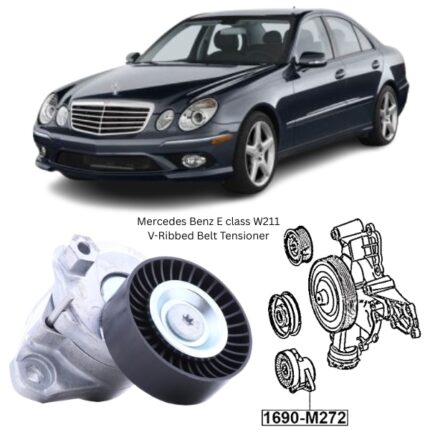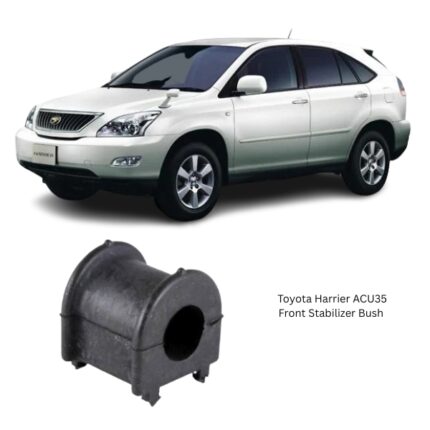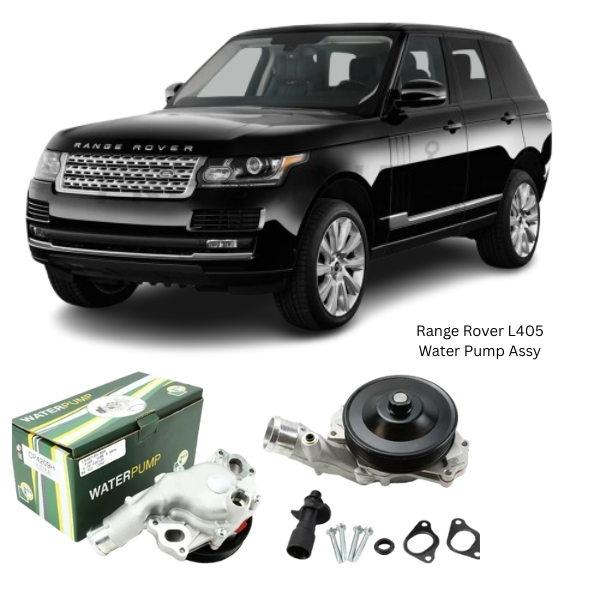-14%
Get Range Rover L405 Water Pump Assy CP4209H in Kenya
The water pump assembly is one of the most critical components in an internal combustion engine’s cooling system. It serves the vital role of circulating coolant throughout the engine block, cylinder head(s), radiator, and heater core to regulate engine temperature and prevent overheating. Though compact in size, the water pump assembly performs a continuous, high-pressure job essential for engine health, fuel efficiency, and long-term durability.
1. Core Function of the Water Pump Assembly
The primary role of the water pump is to keep the engine operating within an optimal temperature range by pumping coolant through a closed-loop system. As the engine runs and generates heat, the water pump propels coolant from the radiator into the engine block and cylinder head(s), absorbing heat in the process. The heated coolant is then cycled back to the radiator, where it releases the heat to the surrounding air before repeating the cycle.
Without this circulation, engine components would quickly overheat, leading to metal warping, gasket failure, oil degradation, and eventual engine seizure. The water pump ensures the uniform distribution of thermal energy, helping maintain efficient combustion and preventing thermal stress across engine parts.
2. Construction and Main Components
A typical water pump assembly is made up of several carefully engineered parts:
-
Pump Housing (Body): Usually made from cast aluminum, cast iron, or composite materials, the housing encloses the impeller and shaft. It is designed to withstand high pressure and thermal stress.
-
Impeller: A rotary blade mechanism (metal or plastic) responsible for propelling coolant through the engine. The impeller’s design (open, semi-open, or closed) influences flow rate and efficiency.
-
Shaft and Bearings: The shaft connects the pulley or gear to the impeller, and precision bearings support this shaft. The shaft must rotate smoothly with minimal resistance.
-
Pulley or Gear Drive: The water pump is driven by either a belt (commonly the serpentine belt or timing belt) or gear, depending on the engine design.
-
Seal and Gasket: The shaft seal prevents coolant from leaking along the rotating shaft, while a gasket ensures a leak-proof seal between the pump and engine block.
-
Weep Hole: A small drain hole built into the housing that allows coolant to escape in case of seal failure, serving as a visual indicator of internal wear.
3. Types of Water Pump Drives
There are two main categories based on the driving mechanism:
a) Belt-Driven Water Pumps
-
Most common in modern vehicles.
-
Powered by the serpentine belt or timing belt.
-
Engine speed directly influences pump rotation speed.
-
Easy to service and replace.
b) Electric Water Pumps
-
Driven by an electric motor instead of a belt.
-
Offers variable-speed operation based on coolant temperature or demand.
-
More precise temperature control.
-
Common in hybrid and high-performance engines.
-
Improves fuel efficiency by reducing engine drag.
4. Coolant Flow Path and Operation
The water pump draws coolant in through its inlet, typically from the lower radiator hose, and pushes it into the engine block and cylinder head(s). Once the coolant absorbs the heat from the engine, it exits via the thermostat housing and travels back to the radiator, where it is cooled before re-entering the water pump.
When the thermostat is closed (cold engine), coolant recirculates within the engine to allow faster warm-up. Once the engine reaches operating temperature, the thermostat opens and allows coolant to pass through the radiator, assisted by the water pump’s flow pressure.
5. Material Composition and Durability
The water pump must withstand constant exposure to high-pressure coolant and fluctuating temperatures. Its materials are selected for strength, corrosion resistance, and wear tolerance:
-
Housing: Often made from aluminum alloys (lightweight, corrosion-resistant) or cast iron (durable in heavy-duty applications).
-
Impeller: May be plastic (lightweight, corrosion-resistant), steel (strong, efficient), or brass (durable, corrosion-resistant).
-
Seals: Ceramic and rubber combinations are common to prevent coolant leaks while withstanding rotational stress.
-
Bearings: High-grade steel with grease-sealed interiors to allow long-life, friction-free operation.
High-quality pumps are designed for service lives of over 100,000 kilometers, provided proper coolant and maintenance routines are followed.
6. Common Signs of a Failing Water Pump
A failing water pump can compromise the entire engine system. Key indicators of wear or failure include:
-
Coolant Leaks: Often visible under the vehicle or around the weep hole, signaling a failing shaft seal.
-
Overheating Engine: Indicates insufficient coolant flow due to pump impeller wear or seizure.
-
Whining or Grinding Noises: Result from bearing failure within the pump.
-
Steam from the Radiator: Caused by overheating, often linked to reduced coolant circulation.
-
Coolant Warning Light: Triggered by reduced pressure or overheating, often connected to water pump malfunction.
7. Installation and Replacement Considerations
Replacing a water pump is a moderately complex task and involves:
-
Draining the Coolant: The system must be emptied to prevent spillage.
-
Removing Drive Belts or Timing Components: Depending on pump design.
-
Unbolting the Pump: Careful detachment from the engine block.
-
Cleaning Mating Surfaces: Essential for proper gasket sealing.
-
Installing the New Pump: Torquing bolts to specification and using fresh gaskets or sealant.
-
Refilling Coolant and Bleeding Air: The cooling system must be properly refilled and free of air pockets to prevent hotspots.
It is often advisable to replace the water pump along with the timing belt or serpentine belt, especially if they share the same access area. This helps save on labor costs and ensures the reliability of related components.
8. Preventive Maintenance and Longevity Tips
To maximize water pump life and overall engine health:
-
Use Correct Coolant Type: Avoid mixing different coolants or using water alone, as improper fluid can cause corrosion and damage internal seals.
-
Flush Coolant Regularly: Contaminated coolant can clog the impeller or erode internal surfaces.
-
Monitor Belt Condition: A failing belt can impair pump function or cause complete stoppage.
-
Inspect Seals and Gaskets: Prevent leaks and pressure loss.
-
Listen for Unusual Noises: Prompt inspection can prevent catastrophic engine failure.
9. Importance in the Engine Ecosystem
The water pump is integral to temperature management and, by extension, engine performance. It enables:
-
Stable Combustion Conditions: By preventing engine knock and ensuring consistent internal temperatures.
-
Lubricant Efficiency: Proper cooling prevents oil breakdown and viscosity loss.
-
Emission Control: Overheated engines emit more pollutants; the water pump helps maintain cleaner operation.
-
Passenger Comfort: By driving hot coolant through the heater core, it also supports the cabin heating system.
A compromised water pump affects not just the engine, but the transmission of heat across many vital subsystems, making it essential for smooth and reliable operation.
Follow us on Facebook for more parts.





Reviews
Clear filtersThere are no reviews yet.